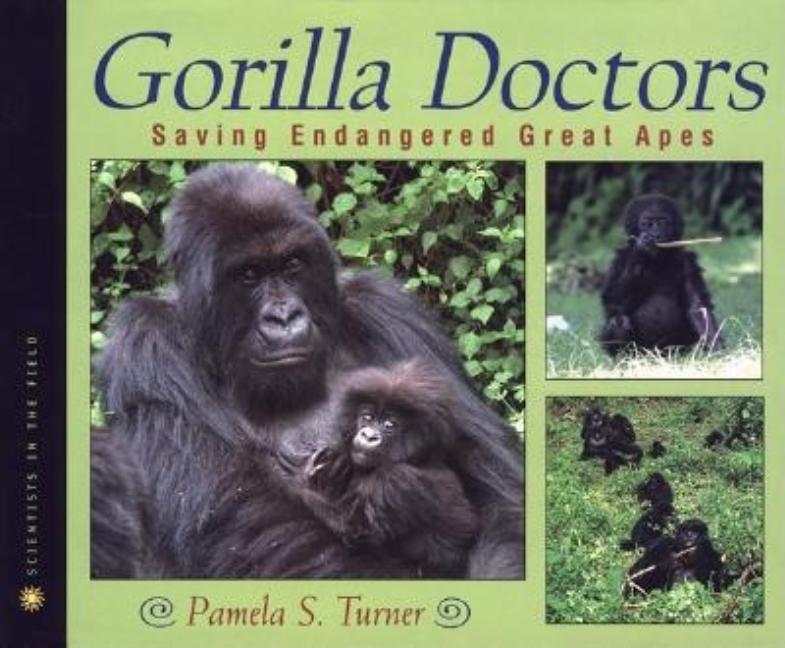Book Descriptions
for Gorilla Doctors by Pamela S. Turner
From Cooperative Children's Book Center (CCBC)
Houghton Mifflin’s outstanding “Scientists in the Field” series provides readers with a window into the lives and work of contemporary scientists. This new title features the staff of the Mountain Gorilla Veterinary Project (MGVP) working with mountain gorillas in Rwanda and Uganda. African and North American scientists, including veterinarians, epidemiologists, and veterinary technicians, work together to protect gorillas threatened by poaching and disease. Pathogens passed between species are a current hot topic in the medical field and the news media, and the text relates how both measles and scabies—illnesses that originated with humans—have recently been discovered in gorillas. In addition to disease research in the field and in the lab, the MGVP works within local schools to educate children about the gorillas and the issues surrounding their welfare. Large color photographs on nearly every page provide visual interest, and a brief resource list of books and web sites suggests ways to find more information. Although this addition to the series doesn’t offer the intimate look at an individual scientist found in earlier volumes, it does give a credible sense of the team work and cooperation required to mount a large-scale conservation medicine project. (Ages 9–13)
CCBC Choices 2006 . © Cooperative Children's Book Center, Univ. of Wisconsin - Madison, 2006. Used with permission.
From the Publisher
The author of The Frog Scientist showcases the work of the Mountain Gorilla Veterinary Project in “an outstanding science nature title” (Kirkus Reviews, starred review)
Mountain gorillas are playful, curious, and protective of their families. They are also one of the most endangered species in the world. For years, mountain gorillas have faced the threat of death by poachers. Funds raised by “gorilla tourism”—bringing people into the forest to see gorillas—have helped protect them. This tourism is vital but contact between gorillas and people brought a new threat to the gorillas: human disease. The Mountain Gorilla Veterinary Project is a group of scientists working to save the mountain gorilla population in Rwanda and Uganda. The gorilla doctors study the effects of human exposure, provide emergency care, and act as foster parents to an orphaned gorilla.
“Excellent photographs prominently feature the scientists at work (predominantly women and people of color in scientific roles) as well as the photogenic gorillas.”—Horn Book, starred review
“The author, who has a degree in public health, is especially successful in explaining how improving community public health benefits both gorillas and humans. Spectacular and appealing photos of gorillas, scientists and the Rwanda Preserve add even more appeal.”—Kirkus Reviews (starred review)
“The readable text records their efforts to treat the great apes in the field as they encounter poachers, meet with loss of habitat, and face their newest threat: human diseases that can cross species lines . . . The whole is accompanied by striking, full-color photographs and includes a list of other resources, a postscript, and an index.”—School Library Journal
Mountain gorillas are playful, curious, and protective of their families. They are also one of the most endangered species in the world. For years, mountain gorillas have faced the threat of death by poachers. Funds raised by “gorilla tourism”—bringing people into the forest to see gorillas—have helped protect them. This tourism is vital but contact between gorillas and people brought a new threat to the gorillas: human disease. The Mountain Gorilla Veterinary Project is a group of scientists working to save the mountain gorilla population in Rwanda and Uganda. The gorilla doctors study the effects of human exposure, provide emergency care, and act as foster parents to an orphaned gorilla.
“Excellent photographs prominently feature the scientists at work (predominantly women and people of color in scientific roles) as well as the photogenic gorillas.”—Horn Book, starred review
“The author, who has a degree in public health, is especially successful in explaining how improving community public health benefits both gorillas and humans. Spectacular and appealing photos of gorillas, scientists and the Rwanda Preserve add even more appeal.”—Kirkus Reviews (starred review)
“The readable text records their efforts to treat the great apes in the field as they encounter poachers, meet with loss of habitat, and face their newest threat: human diseases that can cross species lines . . . The whole is accompanied by striking, full-color photographs and includes a list of other resources, a postscript, and an index.”—School Library Journal
Publisher description retrieved from Google Books.


